The past 12 months has seen some very interesting developments in the ultra-zoom lens market with the launch of the Tamron 150-600 mm f/5-6.3 VC and two new 150-600 mm f/5-6.3 lenses from Sigma. These lenses, combined with the Canon 100-400 f/4.5-5.6 (both the old and new version), Nikkor 80-400 f/4.5-5.6 VR, Sigma 150-500 f/5-6.3, and Sigma 50-500 f/5-6.3 give buyers a larger selection of reasonably affordable long telephoto zoom lens options than ever before.
But there is at least one aspect that is shared between all these lenses despite different brands and parameters – they are all enormous. In this particular review, however, I am going to talk about what is the smallest lens of this class for interchangeable lens cameras, and that is the diminutive (in comparison to the others) 1 Nikon CX 70-300 mm f/4.5-5.6 which has an equivalent field of view of 189-810 mm.
(NOTE: click on images to enlarge them)
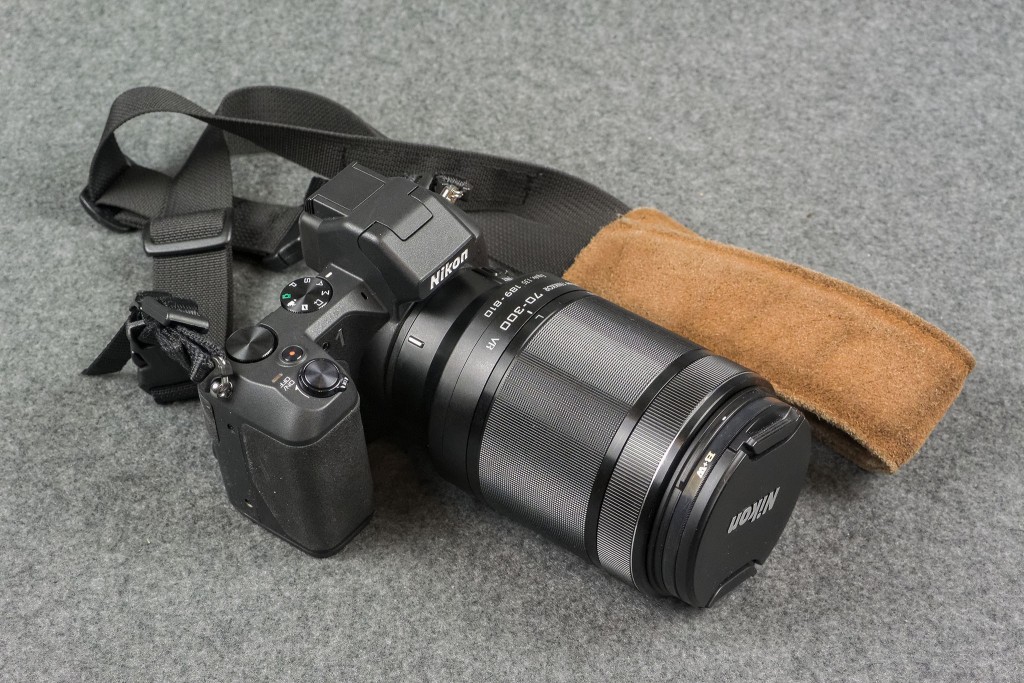
The 1 Nikon CX 70-300 VR f/4.5-5.6 is the smallest and lightest ultra-zoom interchangeable lens that is currently on the market. In its retracted position the lens is only 4.2 inches (108 mm) in length. Fully extended it measures just under 7.5 inches (190 mm), with the hood adding another 2.5 inches (63.5 mm). The lens weighs 19.4 ounces (550 grams). You can see how small this lens is next to a Tamron 150-600 VC:

The CX 70-300 zoom is a variable aperture lens that operates at f/4.5 at its short end and f/5.6 at the long end. This is the same as some other zoom lenses of this general focal length range like the Nikkor 80-400 and the Canon 100-400, and it is slightly better than the Tamron and Sigma offerings purely in terms of light gathering ability. It is designed to work with Nikon 1 system cameras and utilizes the Nikon 1 mount. With the CX sensor in Nikon 1 cameras this lens has a 2.7X crop factor which creates an equivalent field of view of 189 mm to 810 mm when compared to a full frame camera. To be able to hold a camera and an interchangeable lens in the palm of your hand that delivers so much reach is simply amazing.

Before you get into the specs, here is the obligatory squirrel picture that many reviewers seem to include in telephoto lens reviews.

1) Lens Specifications
Here is the list of key specifications:
Mount: Nikon 1
Focal Length: 70-300 mm (189-810 mm equivalent)
Maximum Aperture: f/4.5-5.6
Minimum Aperture: f/16
Minimum Focus Distance: 3.3 – 5.2 ft (1.0 – 1.6 m)
Lens design: 16 elements in 10 groups; Super ED Glass Element; Nano Crystal Coating
Diaphragm: 7 blades (rounded)
Vibration Reduction: Yes
Filter Thread Size: 62 mm
Dimensions (diameter x length): 2.87″ x 4.25″ (73 mm x 108 mm)
Weight: 1.23 lb (560 g)
Tripod Mount: Optional
2) Size, Weight and Build Quality
The first thing that Nikon 1 owners will notice when they pick up this lens is its size and weight. Compared to other 1 Nikon lenses, the 70-300 is significantly larger and heavier. As you can see in the image below, the 70-300 is taller than the 10-100 PD zoom, although not as wide. From a weight perspective, it is marginally heavier than the 10-100 PD zoom, at 1.23 lb (560 grams) compared to 1.14 lb (515 grams). Both of these lenses dwarf the 1 Nikon 30-110 mm which weighs a diminutive 0.40 lb (180 grams).

For someone like me who owns two Nikon 1 V2 bodies, having the CX 70-300 as well as the 10-110 PD zoom (or the non-PD version) would allow to mount one lens on each of the V2 bodies and be able to shoot from 10-300 mm (27 mm to 810 mm full-frame equivalent) without having to change lenses. Add the 1 Nikon 6.7-13 mm into the mix and the focal length coverage expands to 6.7 mm – 300 mm (18 mm to 810 mm full-frame equivalent) with just three lenses. This may make a lot of sense as a travel kit for many Nikon 1 owners as all of that gear would still fit into a fairly small camera bag. The total weight of a 2 body, 3 lens kit such as this would be less than 3.9 lb (under 1.75 kg).
The construction of the CX 70-300 lens appears to be excellent. It definitely feels solid and the zoom operates smoothly. The FULL/LIMIT focus limiting switch feels tight and secure.
3) Controls
The only external control switch on the lens is one for focus limiting with FULL/LIMIT settings. The LIMIT setting is designed to be used if your subject is maintaining a distance of at least 23 feet (7 meters) away from you. Using the LIMIT switch does increase focusing speed slightly when dealing with distant subjects. However, when shooting with this setting engaged on the lens, if your subject moves in closer than 23 feet (7 meters), the lens will not be able to focus automatically. The FULL setting allows for focusing throughout the entire range, and as can be expected, focusing is just a hair slower.
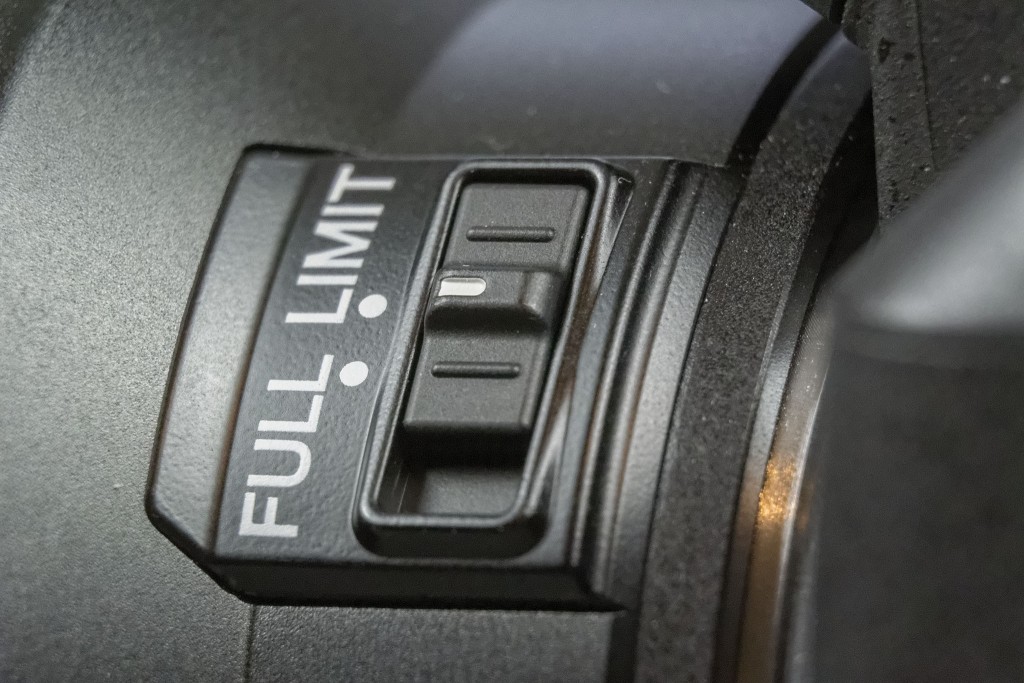
It should be noted that not all Nikon 1 cameras support the LIMIT function and you will need to check your camera’s manual to see if it is supported. Even if your Nikon 1 camera does allow the LIMIT function, you may need to update your firmware to make it operational.
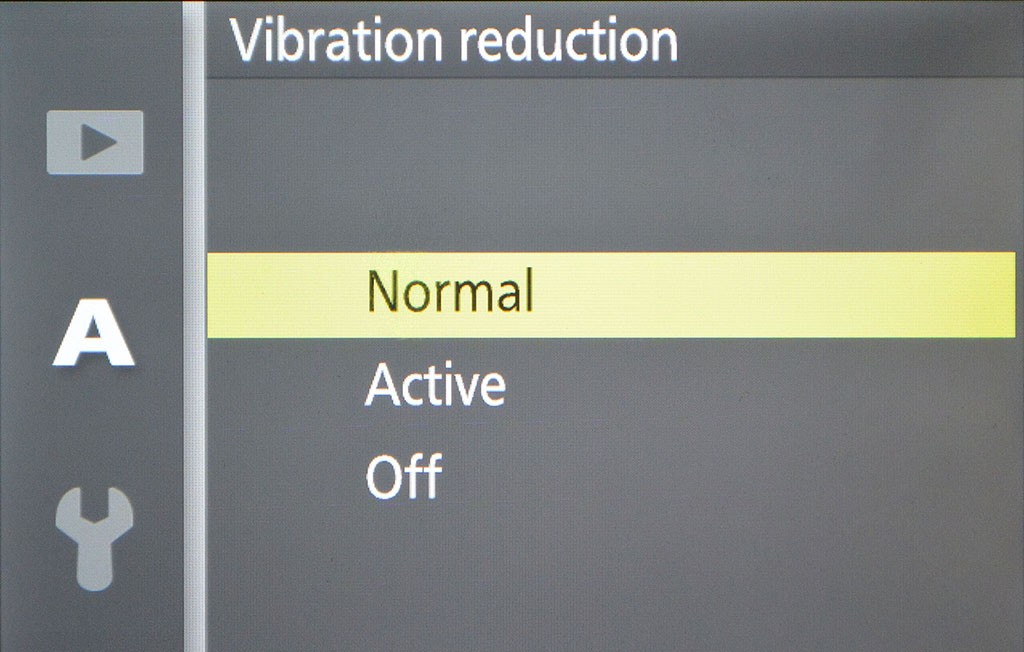
Vibration control cannot be set from the lens and users will need to go into the camera menu to set it for NORMAL, ACTIVE or OFF. NORMAL is the recommended setting for typical day-to-day use. For certain applications, such as recording video when the lens is mounted on a tripod, you may choose to turn the VR off.

Unlike most 1 Nikon lenses, the CX 70-300 has an external focusing ring. This can be used either going into the menu on your camera and setting it for manual focus (MF), or by half-depressing the shutter button while in auto-focus, fine tuning your focusing manually, and then pressing the shutter the rest of the way to capture the photograph.
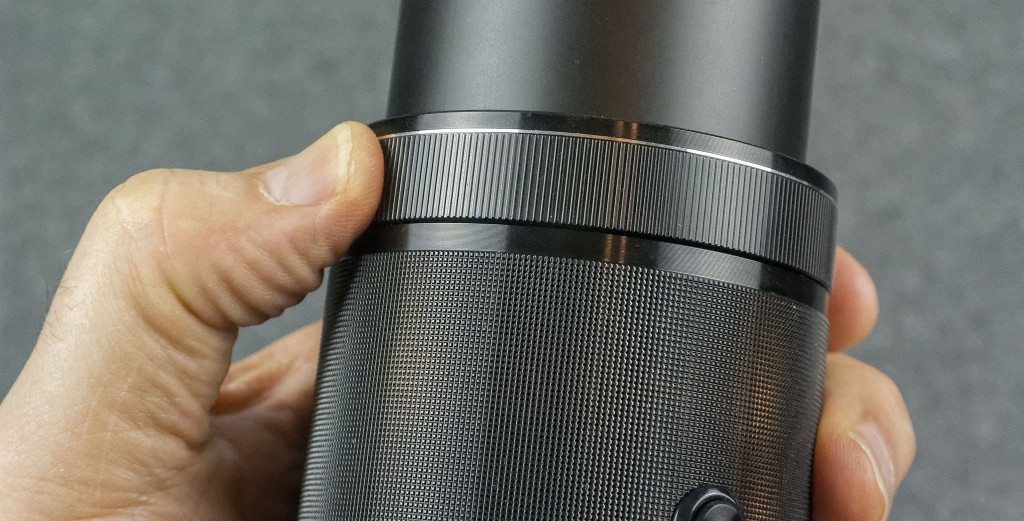
Clockwise rotation of the ring increases the focusing distance, and counterclockwise decreases it. I found using the focusing ring while in auto-focus and half depressing the shutter allowed for more precise focusing and was very useful. When the manual focusing ring is engaged, it automatically causes the image in the viewfinder or on the rear of the camera to be magnified to aid in the manual focusing adjustment. You can adjust what part of your image is magnified by using the “OK” button and depressing the function wheel on the back of camera body.
4) Operation
As with most 1 Nikon zoom lenses, a button on the side of the lens barrel extends the lens to its operating length and also turns on the Nikon 1 camera to which it is mounted. Pushing the button and retracting the lens also turns the camera off. The barrel extends as the lens is zoomed. Only a 1/4th turn on the zoom ring is required to adjust the lens from its minimum to maximum focal lengths. The zoom ring has a well textured surface providing excellent grip, although it is a bit difficult to keep clean.

The bayonet-style lens hood is long and narrow. When mounted on the lens in its reversed position, it covers the release button on the lens barrel so the hood needs to be removed in order for the lenses to be used. It is a good idea to remove the lens cap before installing the hood as I could not reach in to get the lens cap off once the hood was installed. I protect all of my lenses with UV filters and for a lens of the caliber of the 1 Nikon CX 70-300, I certainly would not skimp on a good UV filter. I use a 62 mm B+W multi-coat filter on mine.
The CX 70-300 fits very snugly up against the camera body and you will not be able to attach a quick release plate to the bottom of your camera when this lens is mounted. If you are planning on using a tripod with this lens you will need to buy the optional tripod adapter. I did not bother buying the tripod adapter as I can’t imagine a situation where I would need it in order to shoot stills with this lens. For example, I took a hand-held image of the moon and got acceptable results.

If I was ever to use this lens to shoot nature videos, I would absolutely buy the tripod adapter.
Auto-focus Speed and Accuracy
In almost all situations the focusing is very fast and accurate, especially in good lighting. There can be some minor focus hunting in poor light, but as long as subjects were stationary I did not find this to be an issue.


Birds in flight do present a bit of a challenge. In bright sunlight with mainly blue sky backgrounds creating good contrast with the subject, the focusing worked well and birds in flight can be captured.

However, in overcast conditions or when there is very low contrast with the subject against the background (for example, gulls against a cloudy sky), the focusing speed and accuracy can drop a fair degree making captures difficult and, on occasion, a frustrating experience. So if the main reason why you are considering a long telephoto ultra-zoom lens is to capture birds in flight under a wide range of lighting conditions, the 1 Nikon CX 70-300 may not be your best choice. One of the other long zooms mounted on a DSLR would likely do a better and more consistent job for you, provided that you can handle the size and weight of those other lenses.

From a practical viewpoint, the size and weight of other ultra-telephoto zoom lenses may be beyond your physical capabilities and the 1 Nikon CX 70-300 may be your best solution. If this is the case, there are a few things you can do with your bird-in-flight shooting style to help increase your success rate. These include pre-focusing the lens at the distance you’re anticipating to capture bird images, positioning yourself at a 90-degree angle to flight paths, and shooting in single point auto-focus. The first two factors depend a lot on the behaviour of the bird in question, of course, and is not something you can easily control.

The 1 Nikon CX 70-300 is a much more flexible lens than the other options available since the minimum focusing distance of the CX 70-300 is much shorter than other ultra-zooms on the market (3.3-5.2 feet or 1-1.6 meters). This comes in very handy when shooting in tight quarters. Attaching Vello extension tubes adds even more flexibility and potential for creativity.

When I was shooting at the Niagara Butterfly Conservatory for my recent Photographing Butterflies with the 1 Nikon CX 70-300 article, it occurred to me that I would have been unable to get most of the shots I did that day if I would have had my D800 and Tamron 150-600 with me, even with extension tubes, due to the physical constraints of the venue. Another factor was the necessity to shoot hand-held at fairly slow shutter speeds. The bulk of the D800/Tamron 150-600 VC combination would have been a challenge, even if I was far enough away to actually obtain focus.

One of the “claims to fame” of the Nikon 1 cameras is their ability to do continuous auto-focus at 15 fps or 20 fps depending on the model. Under good lighting conditions this does work pretty well for birds in flight and it is certainly possible to capture a very nice run of images with the CX 70-300. I’ve found that capturing a bird landing on a dock or near its nest is when the AF-C frame rate can capture some truly remarkable images of wing positions. I also had the opportunity to use AF-C at 15 fps to capture some images of a hobbyist’s radio controlled boat. This craft was about four feet long and the thing was literally flying across the water.

At one point it actually became airborne for a split second, a moment I was able to capture thanks to the high frame rate and continuous auto-focus.
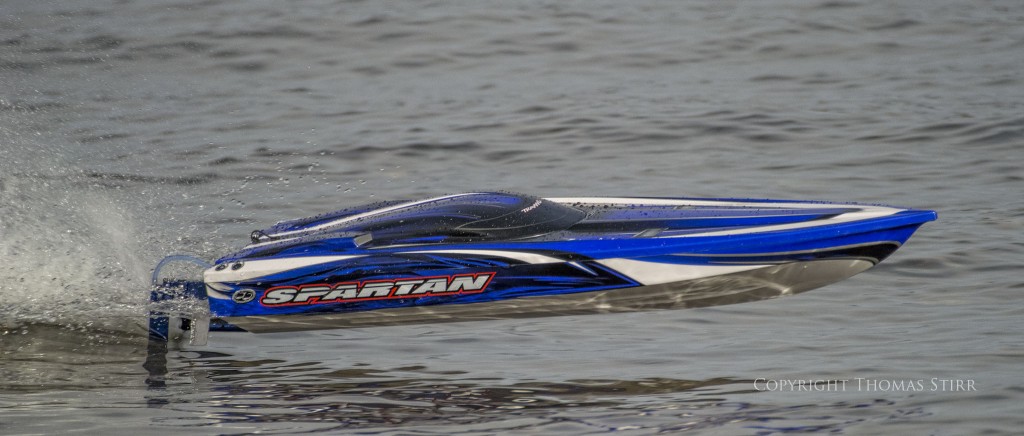
Lens Sharpness and Contrast
Incorporating Super ED glass and Nano Crystal Coating, the CX 70-300 delivers excellent results in terms of rendering richly coloured images with good contrast. Compared to files from the Tamron 150-600 and the Sigma 150-500, I found that I spent much less post-processing time on ones produced with the Nikon CX 70-300. Other than waiting for the PRIME noise reduction in DxO OpticsPro 9 to do its thing, I didn’t spend even a minute on any of the images in this review or in my accompanying YouTube video.

The 1 Nikon CX 70-300 is one of the sharpest lenses I own regardless of format. From my experience, wide open and at full extension is it sharper than my Tamron 150-600 mm and also easily outclasses the Sigma 150-500. There is a good reason why the 1 Nikon CX 70-300 costs as much as it does.
Image Stabilization
The CX 70-300 f/4.5-5.6 is equipped with vibration reduction (VR) image stabilization which, in my experience, works extremely well. I was able to get good, usable shots shooting hand-held at very slow shutter speeds. You’ll see from the images in this review and in my YouTube video that many of them were taken at shutter speeds under 1/100th of a second and some as low as 1/15th of a second. To calculate the equivalent-field-of-view, multiply the focal length in the shooting details by 2.7.


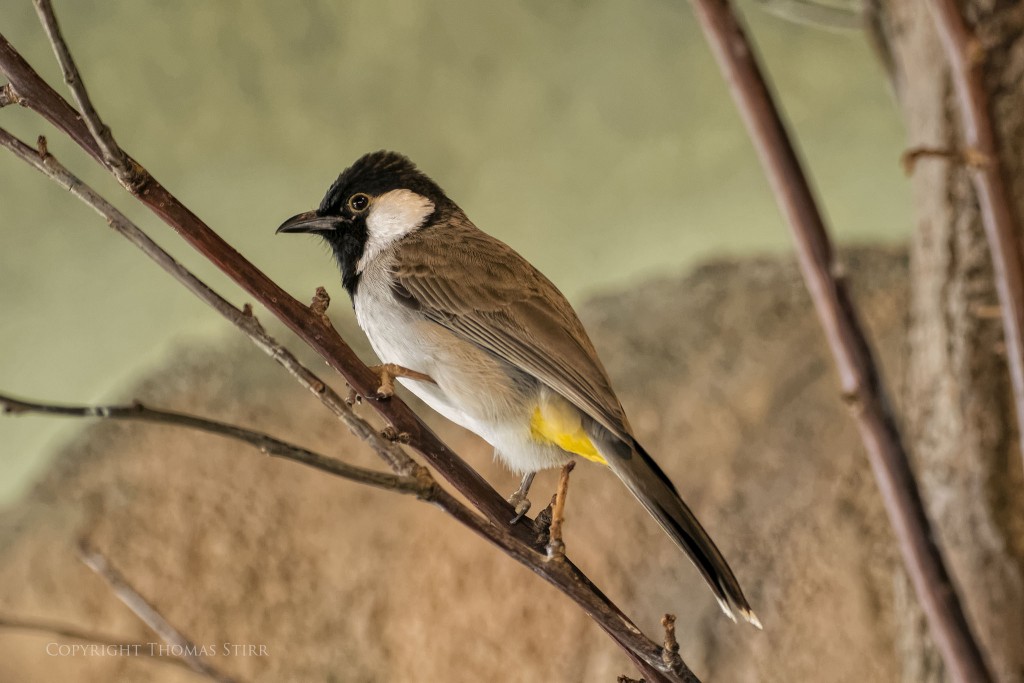
How far did I try to push the VR on the 1 Nikon CX 70-300 lens? As is my style – as far as I possibly could and still get what I consider a usable image for this article. The bird in the following photograph was lying quite still in dark shadows. I did a number of test attempts and was able to get this image at 1/6th of a second and could replicate these results with a 33% or so success rate.

The bird in the following image was moving around slowly with the “step–bob–freeze” motion so common with larger birds. It was taken at an equivalent of 810 mm, hand-held at 1/8th of a second. It is not tack sharp, but, under the circumstances, should give you a good idea of how well the VR performs. Success was hard to duplicate due to movement of the bird and I had only about a 10% success rate.

Most users should be able to get acceptable results hand holding the 1 Nikon CX 70-300 shooting at 1/125th and perhaps as low as 1/60th. If folks are unable to get acceptable results at 1/125th, it will not be the fault of the lens. As always keep in mind that image stabilization at slow shutter speeds will only help you if the subject is stationary.
Low Light Performance
As noted earlier, the CX 70-300 can exhibit a bit of focus hunting in low light conditions, but for stationary subjects this did not prove to be much of an issue.

Nikon 1 cameras are often criticized for their low light performance so I took many of the images for this review under quite challenging lighting conditions to see what my Nikon 1 V2 could do with this lens. To me there is little point in doing a review and only shooting under ideal conditions as readers need to shoot in a range of lighting. While noise can be a factor when shooting at high ISOs with a small sensor camera like a Nikon 1, software with a good noise reduction function like Dxo OpticsPro 10 can really help to extend the ISO shooting range.
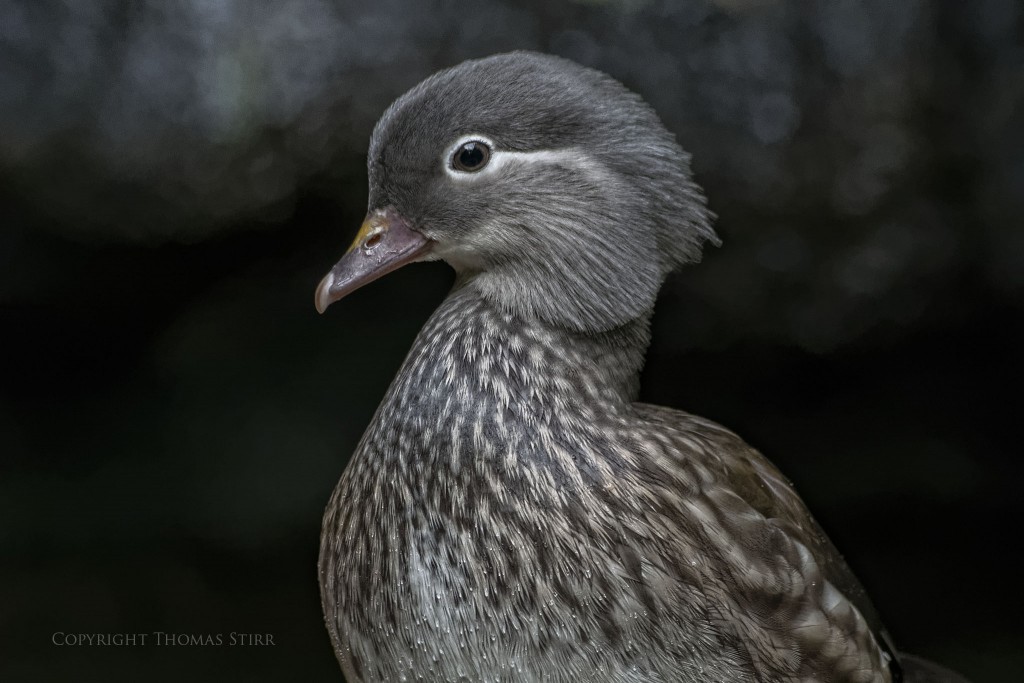
Whether the high ISO images used throughout this review and in my YouTube video would be acceptable to an individual photographer is a subjective assessment and is dependent on an individual’s needs. Since I am not a professional wildlife/animal photographer, I found the resulting image quality was sufficient for my use.
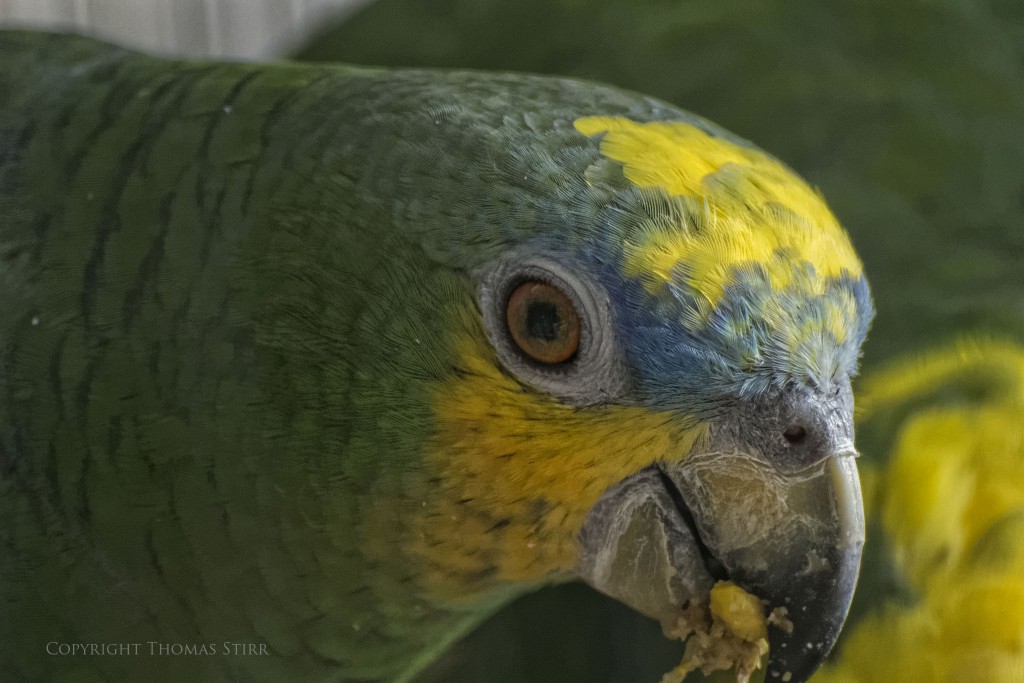
I used my standard post-processing approach with all of the files in this review. Initial RAW processing through DxO OpticsPro 9 with PRIME noise reduction, then a DNG file was exported into CS6 for a couple of minor adjustments, then into Nik Suite for a final tweak or two if needed.
Summary
After shooting extensively with the 1 Nikon CX 70-300 f/4.5-5.6 VR lens for the past couple of weeks, I have fallen in love with it. In my mind it is the “Mighty Mouse” of the ultra-zoom market and is worth every penny of its purchase price. Not only is it sharp and capable of producing beautiful images, its comparatively short minimum focus distance gives it added flexibility. Using extension tubes with it further extends this functionality.
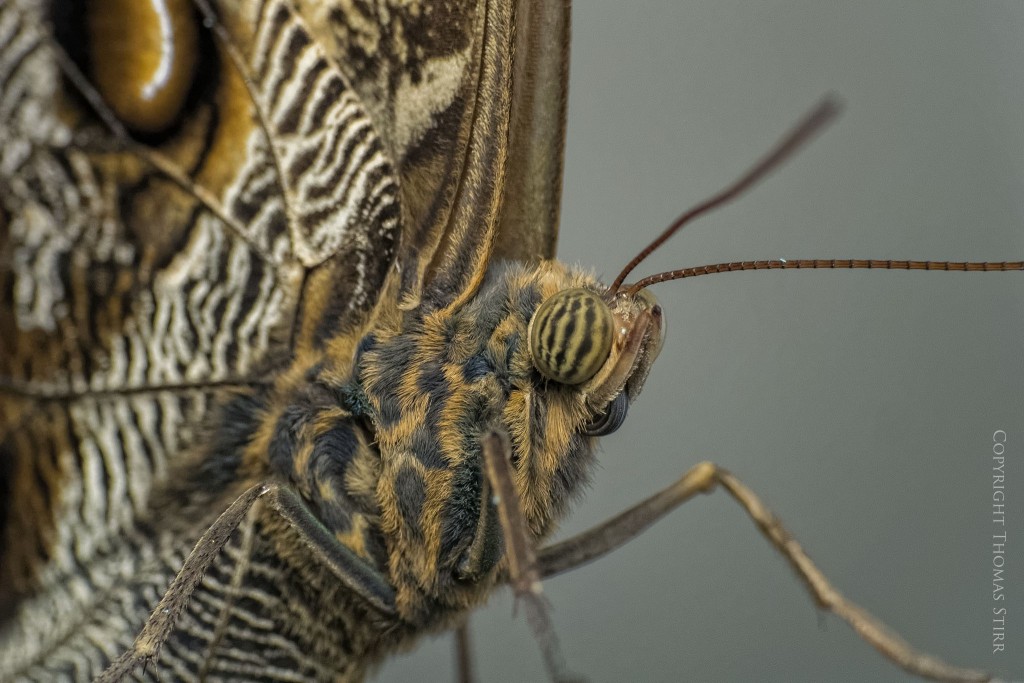
While perhaps not the best choice for photographers looking for an all-conditions solution for shooting a steady diet of birds in flight, the 1 Nikon CX 70-300 excels in so many other ways that it represents a great choice for the majority of people looking for an ultra-zoom lens.
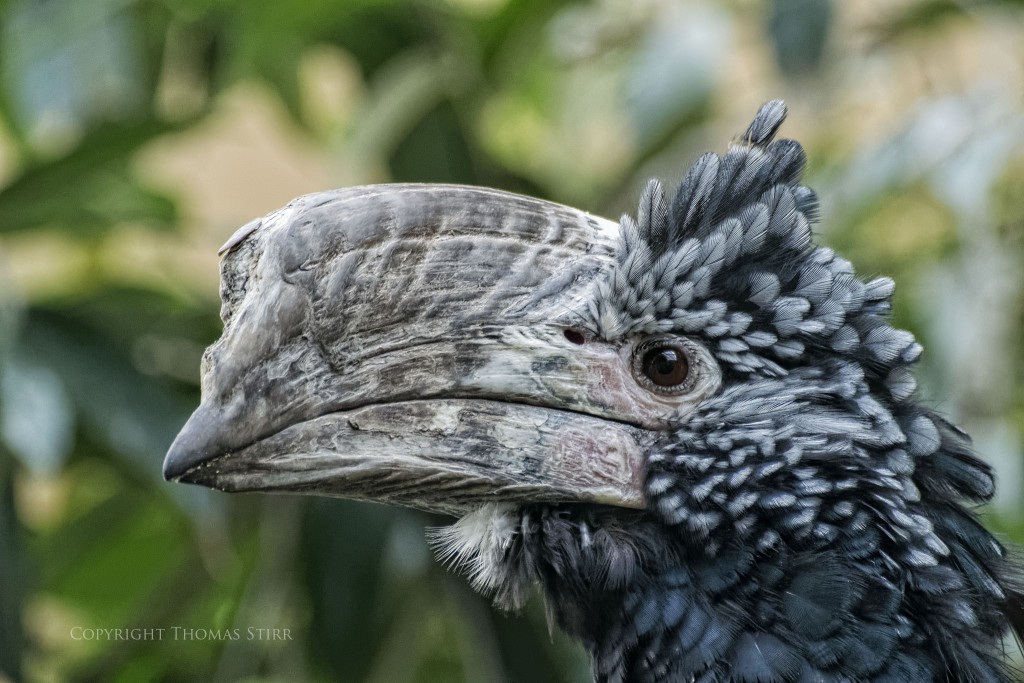
And, for people who simply cannot handle a large, heavy full frame ultra-zoom lens, the CX 70-300 really is the only interchangeable lens on the market offering an equivalent “reach” of 810 mm in a small, easy-to-handle package.
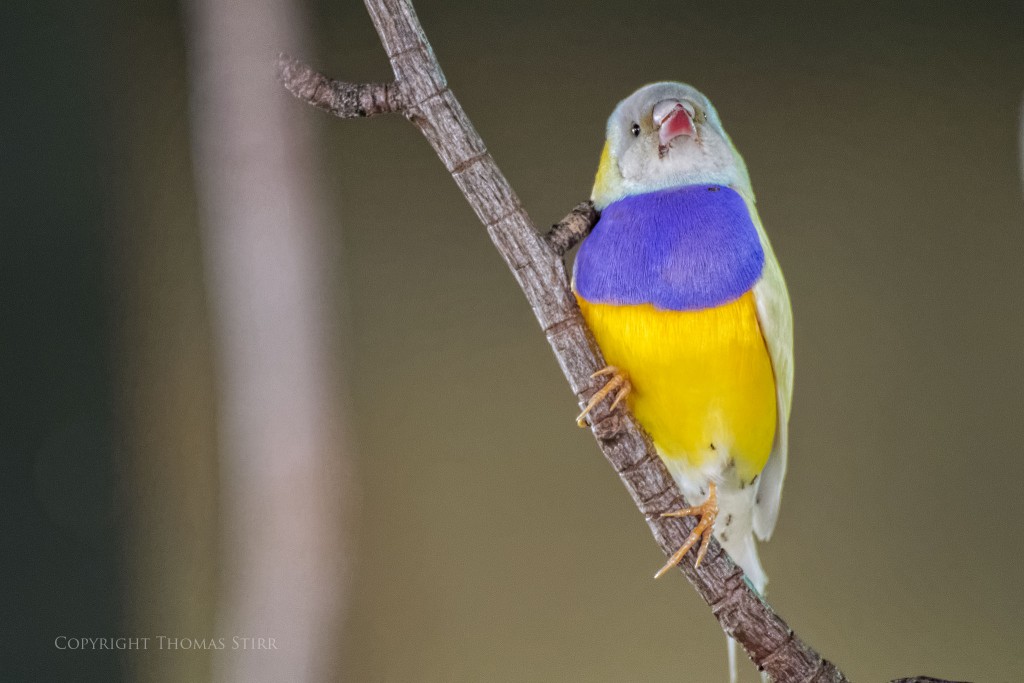
Whether the CX 70-300 VR will get more people considering and eventually buying a Nikon 1 camera or not remains to be seen. On a personal basis I can’t see myself using this lens with anything but a V-Series camera. I need to be looking through a viewfinder when trying to frame a subject, especially when attempting to locate it with a lens this “long”. Attempting to frame a subject using the rear LCD of a camera held away from my eye would frustrate me. Perhaps I’m just an old school shooter.
Additional Sample Images





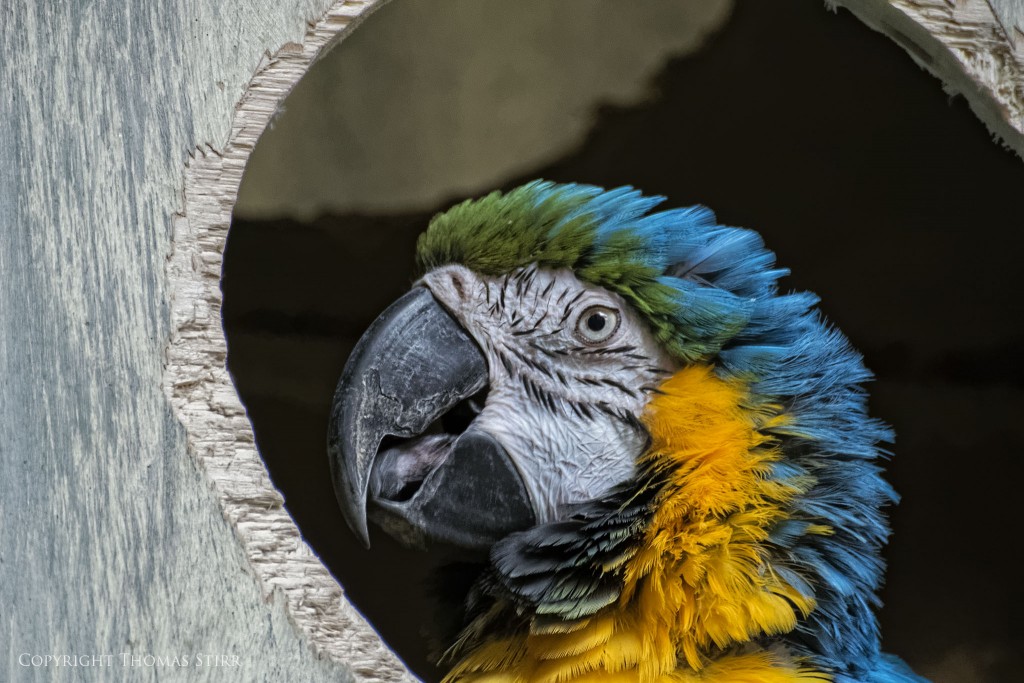
If you enjoyed this article and would like to learn more about the Nikon 1 system, you may want to have a look at our eBook, The Little Camera That Could. It illustrates the capability of the Nikon 1 system through hundreds of original photographs. There is also commentary and tips about the Nikon 1 system.
My intent is to keep this photography blog advertising free. If you enjoyed this article and/or my website and would like to make a modest $10 donation through PayPal to support my work it would be most appreciated. You can use the Donate button below. Larger donations can be made to tom@tomstirr.com through PayPal.
Article and all images Copyright 2014, Thomas Stirr. All rights reserved. No use, reproduction or duplication including electronic is allowed without written consent.



I realize this is a 2+ year old post but your columns, as always, are so helpful. This one helped me decide to buy a used CX 70-300mm lens for my V2.
However, my first shots were not sharp like yours. I tried a tripod and that was better, tried to find an aperture sweet spot – I even blamed the breeze that was blowing!
The problem seemed to be I was shooting with the electronic shutter (silent shutter) rather than the mechanical shutter. Switching to the mechanical shutter made a big difference.
Guess there is enough wiggle on the long end of the lens that the electronic shutter’s read out and rolling shutter-like effects come in to play.
Others might want to try using the mechanical shutter if they encounter similar problems.
Ed
Hi Edward,
Thanks for sharing your experiences using your Nikon 1 V2 and CX 70-300 zoom lens. I haven’t experienced any difference in image sharpness when using the electronic shutter vs the mechanical shutter on my V2s. The majority of my V2 birds-in-flight images were captured using the electronic shutter. I usually use f/5.6 when using the CX 70-300, with the occasional use of f/8. What auto-focusing mode were you using with various subjects? I almost never use the silent shutter when shooting with any of my Nikon 1 gear so perhaps that is why I’ve never had the same experience as you with image sharpness.
Tom
Great review which i enjoyed reading. Very informative.
Thank you.
Hi Bob,
Glad that you enjoyed the review and found it informative.
Tom